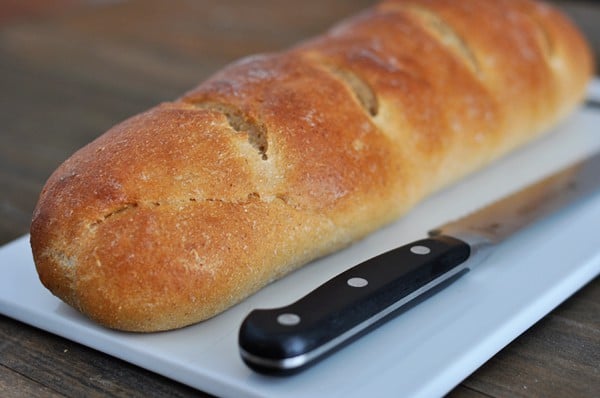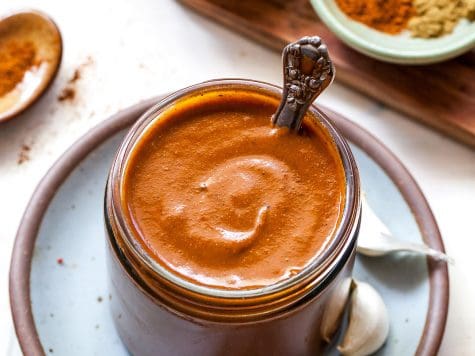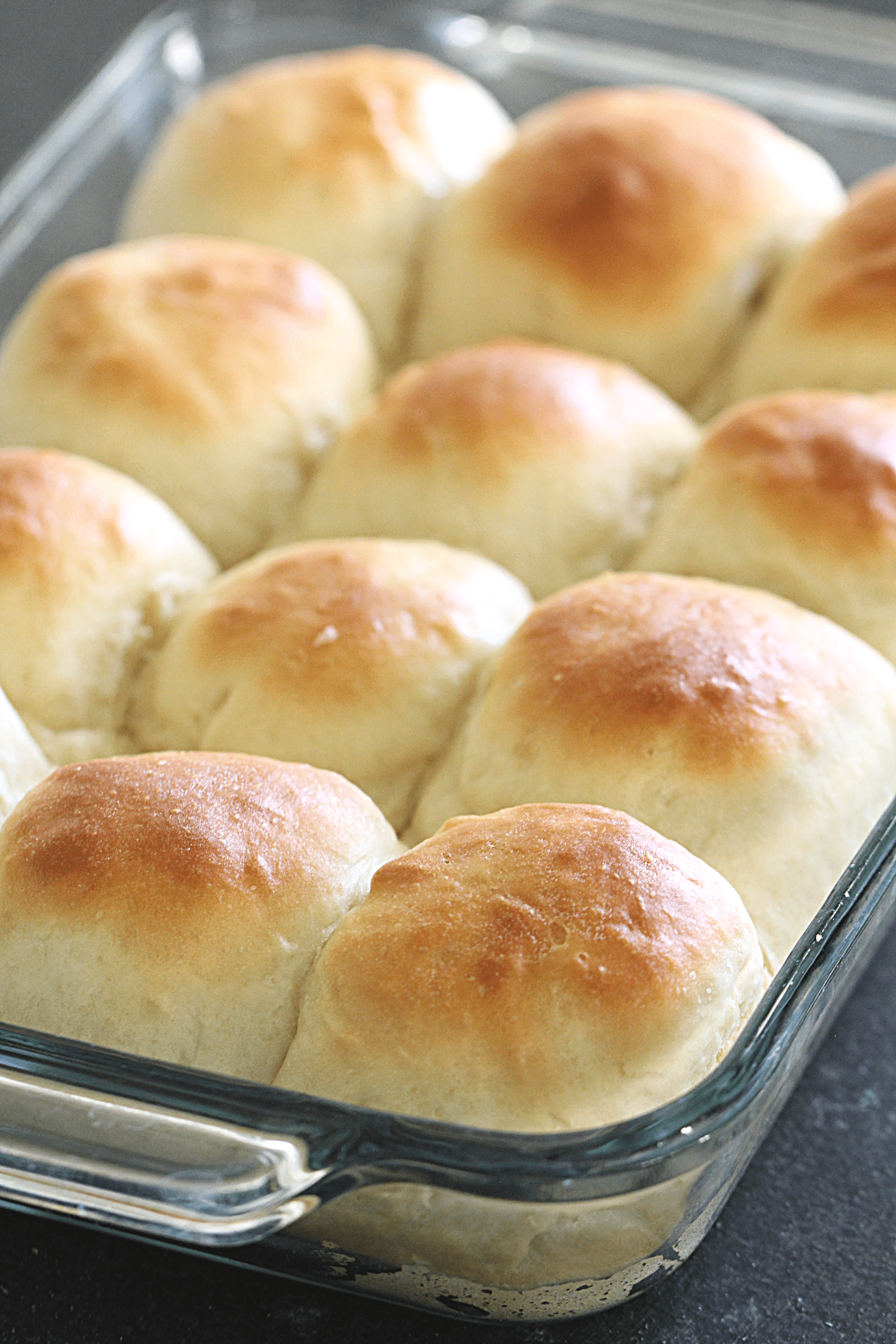Homemade French bread has never been easier! This simple recipe produces a perfect loaf of French bread that will rival any bakery with a super easy tip for getting that crisp outer crust and soft, fluffy inside. Yum!
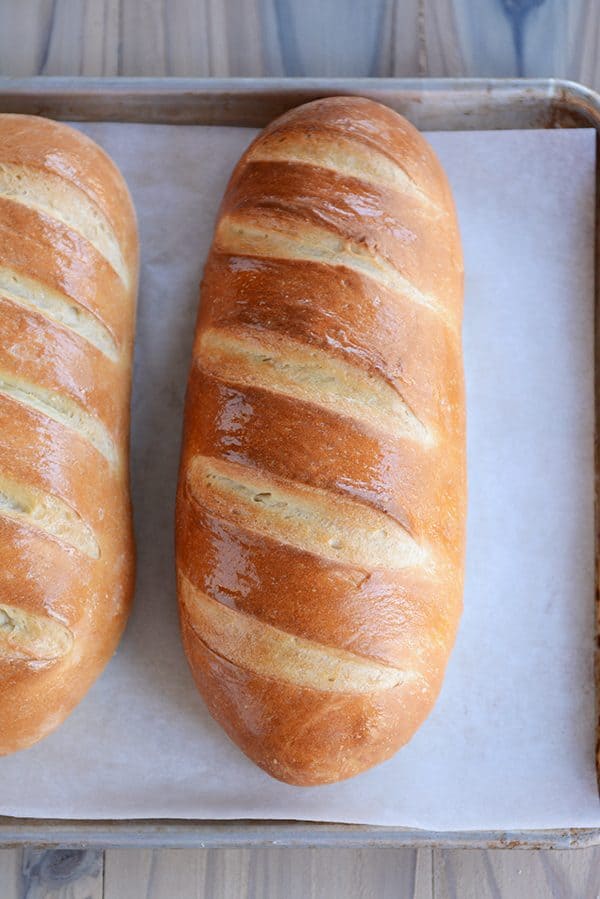
It’s no secret that I love bread.
My love for really good bread rivals my commitment to dark chocolate.
And this easy homemade French bread is right up there with some of my favorite bread in the history of ever.
It is SO simple. So, so simple and perfect for a beginning bread maker.
But it is also jaw droppingly delicious enough for you expert bread makers, too.
This French bread has easily fit into my Best Of bread category for years (many of you have made it and loved it, too!).
And it’s high time it got a makeover and updated recipe post, if you ask me. Plus, I have some fun, new details to share about it!
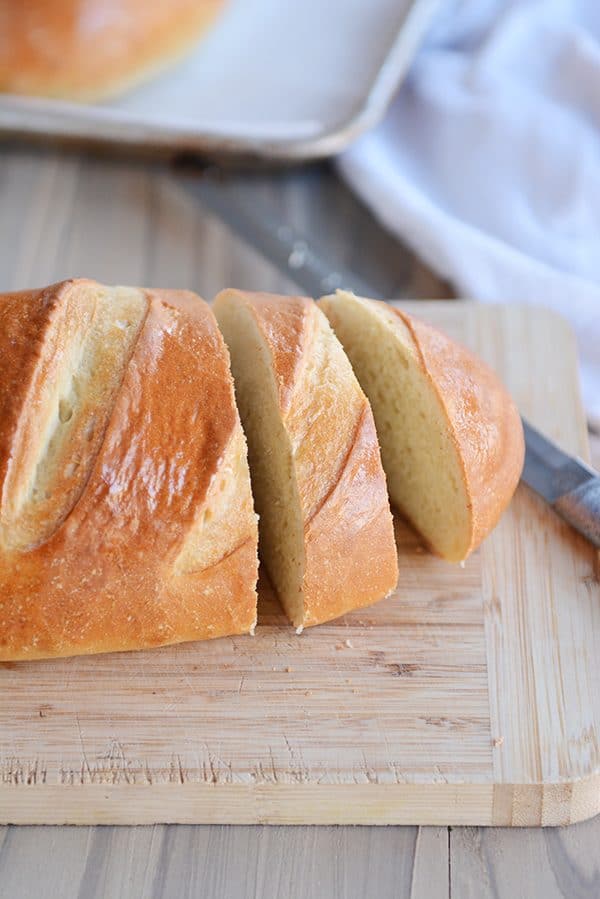
Because I make this bread at least monthly (probably more than that, actually) and have done so for the last 9+ years, I’ve learned a couple things I’d like to share.
Investing (ha!) in a $15 or less baker’s lame (fancy name for bread slashing tool) has upped my bread making game.
Especially with this homemade French bread.
Before, I would choose the sharpest knife in my drawer (admittedly my knives aren’t always as sharp as they should be – oopsie).
And then I would hack at the bread to get artisan-looking slashes, instead deflating the whole life and ending up with flatbread.
Sob.

About five years ago, I found a baker’s lame at a local kitchen store and eyed it warily, wondering if this unassuming, lightweight tool could help me.
And it has, oh it has.
It’s basically a razor blade on a stick shaped in a slight curve to get those gashes and slashes just perfect.
Bonus: I have this one from Amazon now and it’s less than 15 buckaroos.
I use it for my homemade bread bowls, soft pretzel rolls, rustic crusty bread, sweet molasses bread…and any other bread that needs a swift, but loving, gash.
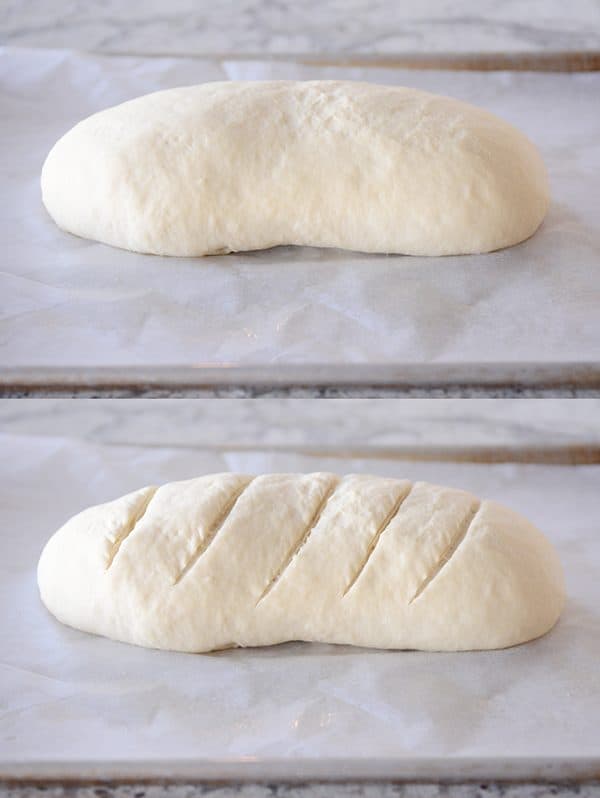
If you have a super sharp razor blade or knife (needs to be extremely thin and sharp so it doesn’t deflate the bread), that should do the trick as well.
The other little variation I’ve added for this homemade French bread is a nifty bread baking hack that I’m pretty sure one of YOU suggested to me years ago in the comments.
And it’s stuck with me – I do it all the time for almost any freeform bread I make now.
Right as you place the bread in the piping hot oven, toss 3-4 ice cubes onto the bottom of the oven and close that door as quickly as you can (but gently! don’t slam it and make the bread fall, for Pete’s sake).
The instant steam as the ice cubes hit the fiery bottom of the oven will lightly crisp up the outer crust as the bread bakes.
And don’t blame me if you shriek in absolute delight and scare the children when your bread comes out of that oven looking (and tasting!) like a legit loaf of bakery French bread.

Truly, this homemade French bread is the stuff dreams are made of.
I make it often to deliver to people that need a pick-me-up or just because I like them or if I’m also taking dinner to someone.
It makes an appearance when we have family fondue night or opt for French bread pizza.
And it is the bread recipe I turn to the most (along with these divine breadsticks) when I need (ok, let’s be serious, when I want) a no-fuss, easy bread to serve with dinner or just use for mood therapy.
Bread can do that you know.
And it makes the best French toast. Just sayin’.
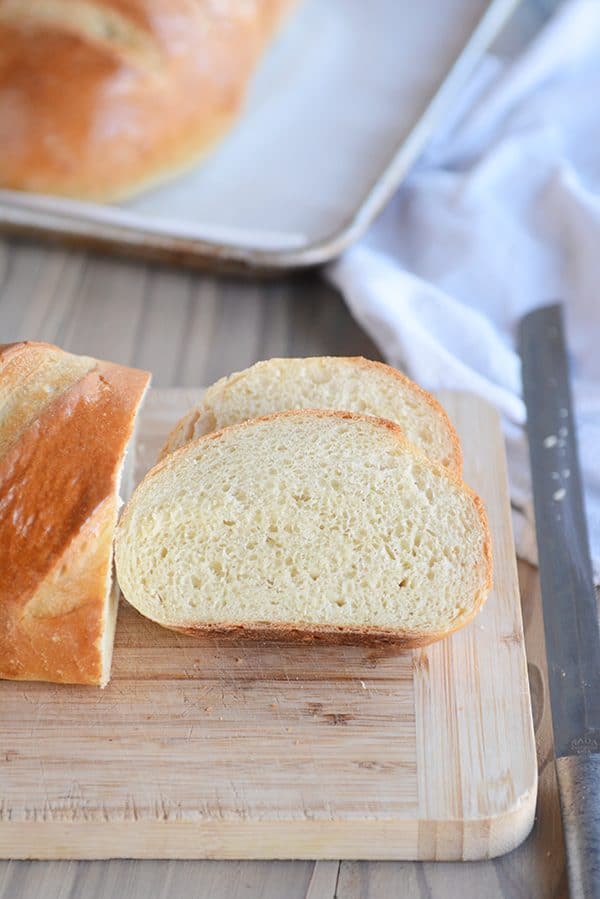
I’ve noted this in the recipe below, but this homemade French bread is also a friend to whole wheat flour.
I make this quite often with at least half whole wheat flour.
And sometimes, I live on the edge and kick the white flour out completely, making it 100% whole wheat.
I’ve found that adding a couple tablespoons of vital wheat gluten, when going the 100% whole wheat route, helps fluff the bread up a bit and avoid the heavy denseness that can come from using whole wheat flour.
FYI: I always use white whole wheat (info on the different varieties of wheat can be found here).
Enough talking! If you haven’t made this homemade French bread, I hope you try it soon! Your life may or may not be changed for the better.
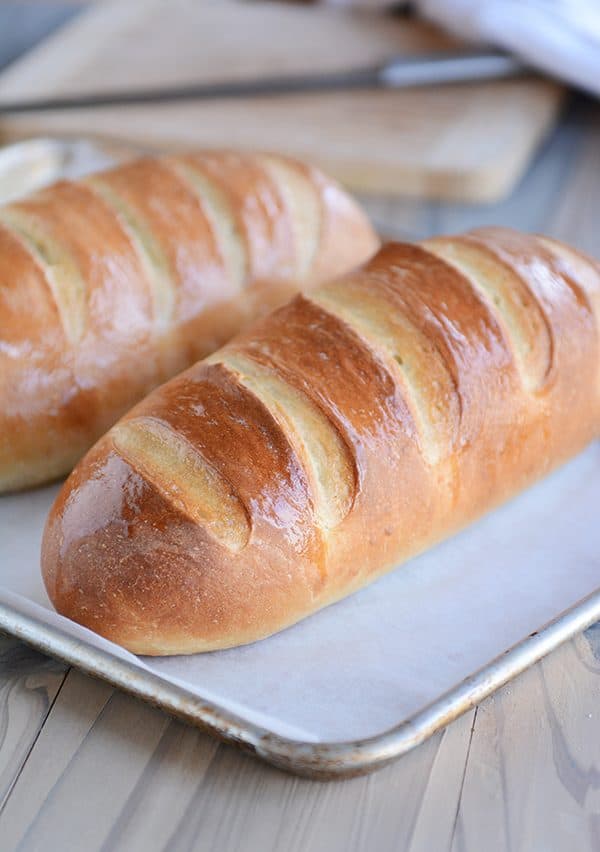
One Year Ago: Harvest Pasta Sauce {Trader Joe’s Copycat}
Two Years Ago: Peanut Butter Cup Cheesecake with Chocolate Cookie Crust
Three Years Ago: Easy Homemade Egg Noodles {Step-by-Step Pictures Include Food Processor Method or By Hand}
Four Years Ago: Black Bean and Butternut Enchilada Skillet
Five Years Ago: Chocolate Chip Peanut Butter and Oatmeal Cookies
Yield: 2 loaves
Easy Homemade French Bread
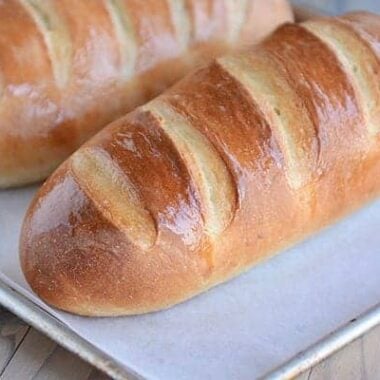
Ingredients:
- 2 1/4 cups warm water
- 2 tablespoons sugar
- 1 tablespoon instant or active dry yeast
- 3/4 tablespoon salt (see note)
- 2 tablespoons olive oil, canola oil, vegetable oil or avocado oil
- 5 1/2 – 6 cups all-purpose flour or bread flour (see note)
Directions:
- In the bowl of an electric stand mixer fitted with the dough hook, combine the water sugar and yeast. If using active dry yeast, let the mixture bubble and foam before proceeding (this can take 3-5 minutes). If using instant yeast, proceed with the recipe (no need to let the yeast activate).
- Add the salt, oil and 3 cups of flour and mix. Add in 2 1/2 to 3 more cups of flour gradually. The dough should clear the sides of the bowl and form a soft ball that doesn’t leave a lot of dough residue on your fingers. Knead for 2-3 minutes until the dough is smooth. If the dough starts to cling to the sides of the bowl (or the center column if using a Bosch or other mixer with a center), add 1/4 cup of flour at a time until a sturdy but soft ball of dough forms.
- Rising Method 1: Leave the dough in the mixer, cover with a lid or towel, and let the dough rest for 10 minutes. Stir it down by turning on the mixer for 10 seconds or so. Repeat the “rest and stir down” cycle five more times.
- Rising Method 2: Instead of letting the dough rest for 10 minute spurts and then stirring it down, transfer the dough to a lightly greased bowl and cover with a towel or greased plastic wrap. Let the dough rise until doubled, about an hour or so, depending on the warmth of your kitchen.
- Turn the dough onto a lightly greased surface and divide in half. Pat each section into a thick rectangle, 9X13-inches or thereabouts (doesn’t have to be exact). Roll the dough up starting from the long edge, pressing out any air bubbles or seams with the heel of your hand, and pinch the edge to seal. Arrange seam side down on a large baking sheet lined with parchment paper (I use separate baking sheets for each loaf).
- Cover with greased plastic wrap or a kitchen towel, and let the loaves rise until noticeably puffy and nearly doubled in size, about an hour.
- Preheat the oven to 375 degrees F and make sure an oven rack is in the center position. With a very sharp knife or baker’s lame cut several gashes at an angle on the top of each loaf (see pictures above in the post for a visual).
- Optional: Place the baking sheet in the hot oven and immediately toss 3-4 ice cubes on the bottom of the oven (this gives a delicious, classic, French bread crispness to the crust). Close the oven door quickly.
- Bake for 25-30 minutes until golden and baked through. Remove from the oven and slather with melted butter (optional, but delicious). Repeat with the 2nd loaf (or if you have convection setting, the loaves can bake at the same time, just rotate the baking sheets halfway through baking).
Notes:
As with all yeast doughs, I never use the flour amount called for in the recipe as a hard fast rule (unless a weight measure is given and then I pull out my kitchen scale). Because humidity, temperature, altitude and a multitude of other factors can impact how much flour you need in your yeast doughs, I always judge when to quit adding flour by the texture and look and feel of the dough rather than how much flour I’ve added compared to the recipe. This tutorial on yeast may help identify how a perfectly floured dough should be.
Also, I often use half to 3/4 finely ground white whole wheat flour with good results – and sometimes I get crazy and use 100% whole wheat flour (always finely ground white wheat) but the bread is a bit more dense with 100% whole wheat flour. If using part or all whole wheat flour, add a few minutes to the kneading time to help develop the gluten (adding a couple tablespoons of gluten flour can also help the whole wheat bread bake up light and fluffy).
The original recipe called for 1 tablespoon salt; over the years I’ve decreased that amount just slightly.
If you don’t have an electric mixer, this dough can be made by hand using a large bowl and a wooden spoon the good old-fashioned way!
All images and text ©.
Follow @melskitchencafe on Instagram and show me the recipes you are making from my blog using the hashtag #melskitchencafe. I love seeing all the goodness you are whipping up in your kitchens!
Recipe Source: from The Sister’s Cafe
Recipe originally published June 2008; updated with new pictures, recipe notes, commentary.
Disclaimer: post contains an affiliate link for the baker’s lame I bought from Amazon.
